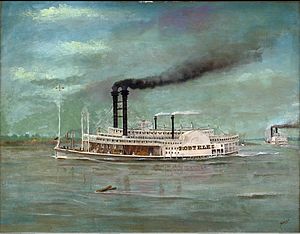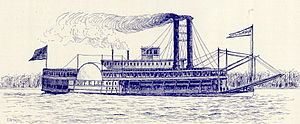Robert E. Lee (steamboat)

 Robert E. Lee, drawing by Samuel Ward Stanton (1870-1912)
| |
| History | |
|---|---|
| Name | Robert E. Lee |
| Owner | Capt. John W. Cannon[1] |
| Route | Mississippi river |
| Launched | 1866, at New Albany, Indiana |
| In service | 1866 |
| General characteristics | |
| Type | inland steamboat |
| Tonnage | 1467 |
| Length | 285.5 ft (87.02 m) |
| Beam | 46 ft (14.02 m) |
| Installed power | twin high-pressure steam engines; cylinder bores 40 inches (101.6 cm); stroke 120 inches (304.8 cm); eight iron boilers each 46 feet (14.02 m) long and 27 inches (68.6 cm) diameter, working steam pressure 120 lbs.[1] |
| Propulsion | sidewheel |
The Robert E. Lee, nicknamed the "Monarch of the Mississippi," was a steamboat built in New Albany, Indiana in 1866. The hull was designed by DeWitt Hill, and the riverboat cost more than $200,000 to build.[2] It was named for Robert E. Lee, General-in-Chief of the Confederate States of America, and the steamboat gained its greatest fame for racing and beating the then-current speed record holder, the Natchez, in an 1870 steamboat race.[3][4]
Description
Its capacity was 5741 bales of cotton.[5]
A local newspaper in New Albany described it:
The cabin and outfit of this great southern steamer surpasses that of any boat that has yet graced the trade, and her accommodations are on the same scale of grandeur and magnificence. She has sixty one staterooms in the main cabin, twenty four extra rooms in the texas for passengers, a nursery for servants and children, and a cabin adjoining the nursery in which are staterooms for fifty passengers. … The main cabin carpet is a single piece 17 ½ feet wide and upwards of 225 feet (69 m) in length, a royal Winton velvet purchased of A. T. Stewart of New York and made to order. The furniture also made to order, all of modern style and costly materials in fact solid rosewood, the chairs, sofas, sociables, etc., most artistically and elaborately carved. The cushions of all seats are heavy crimson satin, and the style of the furniture is of new and original design, all made in this city at the manufactory of John Sim. She has 20 extension dining tables in the main cabin, each to accommodate twelve guests; thus seating 240 for dinner with plenty of room for extra side tables. … The machinery of the ROB'T. E. LEE consists of feet stroke, the largest high pressure engines on the river. … The doctor is considered a triumph of the medical art, it being a new style of with the parallel motion applied. It supplies the boiler with water and can throw an immense volume. The boat is also furnished with three separate pumping fire engines with an abundance of hose to use in case of fire. … She has wrought iron shafts weighing 18,750 pounds, the shafts being each 23 feet (7.0 m) in length, with the journals 18 inches (460 mm) in diameter. Each of the cranks, which are also of wrought iron, weigh 6,000 pounds. These were all made east of the Alleghenies and are the largest ever constructed for a western steamer. The texas is 140 feet (43 m) in length, with 24 passengers rooms in addition to the accommodations for officers. She also has two immense baggage rooms, all under guard. … to obviate the necessary of carrying baggage in the cabins or on guard. … The cabin with its rich garniture and splendid furniture, dazzling chandeliers, arched and fretted ceilings, etched with gold, stained glass skylights, immense mirrors, the velvet carpet, the pure zinc white of sides, the rosewood state room doors, and the imitation Egyptian marble stills, all combined to make it bear an appearance of Oriental luxury and splendor seldom conceived an never before seen floating the wild waters of this so-called semi-barbarian western world. …[6]
History

In 1870, the Robert E. Lee won a famed steamboat race against the Natchez, going from St. Louis, Missouri to New Orleans, a distance of 1,154 miles (1,857 km), in 3 days, 18 hours and 14 minutes. John W. Cannon, the captain of the Lee, ensured victory by removing excess weight, not allowing passengers, and using prearranged barges to increase the speed of refueling. The Natchez finished the race with the speed of 3 days, 21 hours and 58 minutes, but was delayed by a sandbar for six hours, and had numerous passengers to weigh it down.[7] To this day no commercial boat has beaten the speed record set by the Lee during the race.[2] However, the Bogie, a 1929 motor boat built by Leroy Craft, beat the Lee's record.[8]
It usually ran between New Orleans and Natchez, Mississippi. However, during spans of bad business, it would forsake Natchez and instead go to St. Louis or Louisville, Kentucky.[2]
Fate

At 3:30 am on September 30, 1882, the Lee caught fire thirty miles north of New Orleans, at Point Pleasant, killing 21 people. It had left Vicksburg, Mississippi heading for New Orleans, on its first voyage since being repainted. The fire started in the pantry and spread, destroying nearly everything on board, including the ship's books, mail, and 500 bales of cotton. Some crew members believed the fire to be accidental, while others suggested that it might have been deliberately set. When the fire was discovered, the boat headed to shore at the Yucatán Plantation in Louisiana. The captain was W.S. Cannon (son of Capt. John Cannon, who owned the steamboat), and the pilot, John Stout, was credited with saving many lives. The survivors were rescued by the J. M. White, and taken back to Vicksburg.[9]
Three chandeliers originally on the Lee are currently at the First Presbyterian Church of Port Gibson, Mississippi.[10] Another chandelier is in the St. Louis Cathedral in New Orleans. Additional items originally of the Lee are at the Howard Steamboat Museum in Jeffersonville, Indiana.[11]
A stern wheel steamer named Robert E. Lee was built in 1969 based on an old Corps of engineers hull. Moored as a floating restaurant in St. Louis, this boat was destroyed by fire in 2010. It was not a replica of the original Robert E. Lee which was a larger side wheel steamer.
In Popular Culture
- In 1912 Lewis F. Muir and L. Wolfe Gilbert composed the song On The Robert E. Lee , which describes the Robert E. Lee sailing to New Orleans. It was performed by Al Jolson in the 1927 film The Jazz Singer.
- Robbie Robertson and Levon Helm composed The Night They Drove Old Dixie Down and performed it with The Band. The song depicts the last days of the Civil War.
References
- ^ a b Stanton, Samuel Ward, American Steam Vessels, New York, Smith and Stanton 1895, page 197.
- ^ a b c The Drawings of the Mississippi River Steamer 'ROBERT E. LEE'
- ^ The Riverboats Natchez
- ^ Natchez Under The Hill Saloon - Natchez Mississippi
- ^ Robert E. Lee, Riverboat
- ^ New Albany Ledger October 6, 1866
- ^ The Great Mississippi Steamboat Race
- ^ The Atlanta Constitution July 26, 1929
- ^ The New York Times, October 1, 1882
- ^ Home | steamboats.org
- ^ The Howard Saga
External links
- (1882-10-01) Template:PDFlink The New York Times
